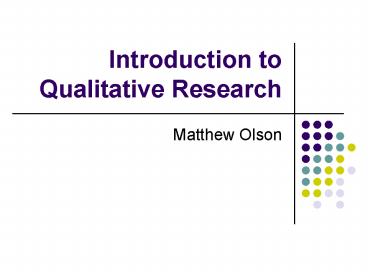Introduction to Qualitative Research - PowerPoint PPT Presentation
1 / 22
Title:
Introduction to Qualitative Research
Description:
Uses a quasi-experimental design. Attempts to control personal bias ... Strauss recommends the technique of frequent memos as an analysis technique. ... – PowerPoint PPT presentation
Number of Views:124
Avg rating:3.0/5.0
Title: Introduction to Qualitative Research
1
Introduction to Qualitative Research
- Matthew Olson
2
Quantitative Educational Research Paradigm
- Uses a quasi-experimental design
- Attempts to control personal bias
- Establishes a control group and experimental
group - Makes comparisons
- Determines statistical significance at p .05
- Assumes random a sample
- Seeks to generalize results to a larger context
3
Qualitative Educational Research Paradigm
- Maxwell (1996) says qualitative research is good
for understanding - meaning, and participants perspectives
- context across individuals and across situations
- unanticipated phenomena in exploratory studies
and identifying variables which may emerge - unfolding processes
- cause and effect relationships.
4
Research Questions
- Use why questions
- Use how questions
- Seek to describe, not compare
- Seek to understand relationships (but not
correlations, rather interactions) - Describe the nature of a phenomenon as it occurs
over time
5
Theoretical Foundations
- Should be consistent with your personal beliefs
(you are part of the methodology!) - Inform research questions
- Inform the unit of analysis you determine
- Am I looking at professors? Students? Activities?
- Inform data sources you investigate
6
Example Olson (2007)
- Viewing learning through the theoretical lens of
Social Constructivism creates special emphases
on - Collaboration among learners (Vygotsky, 1978
Dewey) - Application of knowledge (Dewey, Brooks and
Brooks) - Real-world connections (Brooks and Brooks)
7
Methodologies
- Case studies
- Single case study
- Multiple case study
- Ethnography
- Capture multiple perspectives
- Activity embedded in socio-cultural contexts
8
Sampling
- If you are interested in studying something, look
where you might expect to find it. - Intentional or purposeful sampling (Maxwell,
1997) - Sample size is less important since you are
generalizing back to theory (more on this later) - Consider case of one (analogs to the study of
the natural world)
9
Data Sources
- Documentation
- Participant-observation
- Interviews
- Open ended surveys
- Direct observation
- Archival records
- Physical artifacts
10
Validity and Reliability
- Construct validity
- Do you measure what you claim to?
- Internal validity
- External validity (generalization)
- Reliability
- Is this case repeatable?
11
Construct and Internal Validity
- How are the questions are you are asking related
to the data sources you have chosen? - What are your operational definitions?
- What is the chain of data?
- How will you look for patterns in the data?
12
Triangulation
- Data triangulation multiple data sources
- Investigator triangulation - multiple
investigators - Theory triangulation
- Methodological triangulation
13
Convergence of Evidence
Reproduced from Yin (1994)
14
Memos
- Strauss recommends the technique of frequent
memos as an analysis technique. - Memos can be short, one-page notes to yourself
about your developing ideas regarding your
research
15
Member Checking
- Member checking activities have you reflecting
your evolving ideas with the study participants - Some studies use key informants who have a
greater connection to the study and engage more
frequently in member checking
16
Data Analysis Using Software
- NVivo software
- Used for developing categories of data
- Documenting and exploring developing hypotheses
- Adding a quantitative component
17
NVivo Example
18
External Validity
- Generalizing to what?
- Statistical generalization - from a sample to a
universe - Analytical generalization - from a case to
broader theory
19
Sharing Findings
- Use natural language of participants for emphasis
(quotes) - Establish a graphic model to convey relationships
(example, next slide)
20
Example Model
21
Questions to think about
- Valid applies to arguments and conclusions, not
to your methodology - How am I enriched after having done this
research? - How have I defined validity for myself?
- What validation methods did I use?
- Have I taken advantage of member checking?
- How is what I found grounded in the
methodological literature? How does it go beyond?
22
References
- Case Study Research, Design Methods, Yin (1994)
- The Art of Case Study Research, Stake (1995)
- Research Design, Qualitative and Quantitative
Approaches, Creswell (1994)































